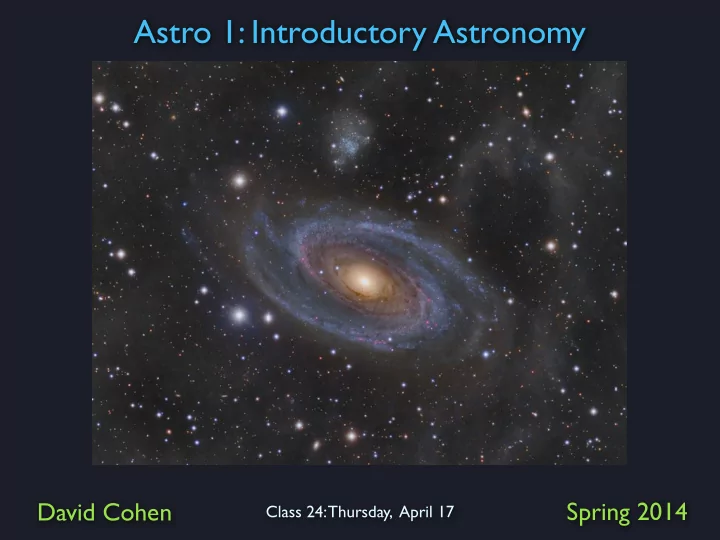

Astro 1: Introductory Astronomy David Cohen Spring 2014 Class 24: Thursday, April 17
http://apod.nasa.gov/apod/ap130310.html
Figure 19.1
http://apod.nasa.gov/apod/ap130429.html
the “coal sack” - opaque http://apod.nasa.gov/apod/ap080707.html dust cloud
Composite of images taken from the Earth’s surface http://apod.nasa.gov/apod/ap110520.html
http://apod.nasa.gov/apod/ap110520.html Galactic center
1757 based on star counts in different directions William and Caroline Herschel They didn’t recognize that dust was absorbing the light from more distant stars, so their estimate of the Galaxy’s size was too small, and they also therefore incorrectly thought that we were close to the center.
Two open clusters - relatively young The smaller a cluster looks, the farther away it should be
Consider two open clusters, X and Y The stars in cluster X are, on average, 4 times brighter than the stars in cluster Y Which cluster is farther away, X or Y? How many times farther away is it?
Consider two open clusters, X and Y The stars in cluster X are, on average, 4 times brighter than the stars in cluster Y Which cluster is farther away, X or Y? Y is farther away How many times farther away is it? It is 2 times farther away
Consider two open clusters, X and Y The stars in cluster X are, on average, 4 times brighter than the stars in cluster Y So if cluster X is one degree across, what should the angular size of Y be?
Consider two open clusters, X and Y The stars in cluster X are, on average, 4 times brighter than the stars in cluster Y So if cluster X is one degree across, what should the angular size of Y be? 2 times farther away, 2 times smaller in angular size: half a degree
Consider two open clusters, X and Y The stars in cluster X are, on average, 4 times brighter than the stars in cluster Y 2 times farther away, 2 times smaller in angular size: half a degree But what if there is dust making the more distant cluster even dimmer? Is it really closer or farther than you’d previously estimated?
Consider two open clusters, X and Y The stars in cluster X are, on average, 4 times brighter than the stars in cluster Y But what if there is dust making the more distant cluster even dimmer? Is it really closer or farther than you’d previously estimated? closer (since some of the dimness is due to dust, not distance)
Consider two open clusters, X and Y The stars in cluster X are, on average, 4 times brighter than the stars in cluster Y So, will the cluster be bigger or smaller than half a degree?
Consider two open clusters, X and Y The stars in cluster X are, on average, 4 times brighter than the stars in cluster Y So, will the cluster be bigger or smaller than half a degree? bigger!
http://apod.nasa.gov/apod/ap120129.html
Infrared image on the right: dust is more transparent in the infrared
Globular clusters are distributed symmetrically around the center of the Milky Way; and since they’re not in the disk, they’re much less subject to dust absorption http://apod.nasa.gov/apod/ap130501.html
A coherent picture of the Milky Way emerged by the mid-20th Century
Disk and Halo stars have different sorts of orbits
Recommend
More recommend